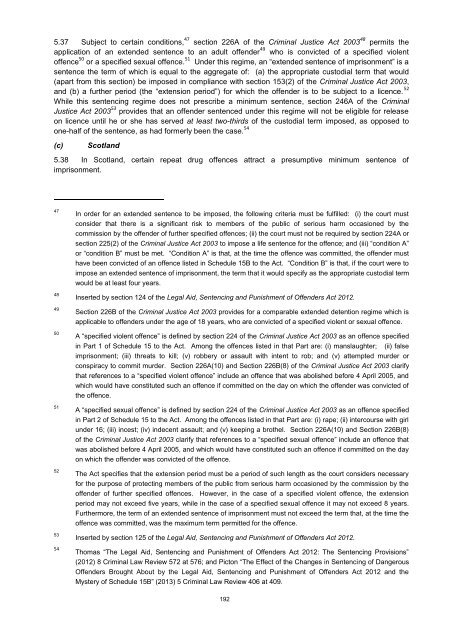Report on Mandatory Sentences - Law Reform Commission
Report on Mandatory Sentences - Law Reform Commission
Report on Mandatory Sentences - Law Reform Commission
Create successful ePaper yourself
Turn your PDF publications into a flip-book with our unique Google optimized e-Paper software.
5.37 Subject to certain c<strong>on</strong>diti<strong>on</strong>s, 47 secti<strong>on</strong> 226A of the Criminal Justice Act 2003 48 permits the<br />
applicati<strong>on</strong> of an extended sentence to an adult offender 49 who is c<strong>on</strong>victed of a specified violent<br />
offence 50 or a specified sexual offence. 51 Under this regime, an “extended sentence of impris<strong>on</strong>ment” is a<br />
sentence the term of which is equal to the aggregate of: (a) the appropriate custodial term that would<br />
(apart from this secti<strong>on</strong>) be imposed in compliance with secti<strong>on</strong> 153(2) of the Criminal Justice Act 2003,<br />
and (b) a further period (the “extensi<strong>on</strong> period”) for which the offender is to be subject to a licence. 52<br />
While this sentencing regime does not prescribe a minimum sentence, secti<strong>on</strong> 246A of the Criminal<br />
Justice Act 2003 53 provides that an offender sentenced under this regime will not be eligible for release<br />
<strong>on</strong> licence until he or she has served at least two-thirds of the custodial term imposed, as opposed to<br />
<strong>on</strong>e-half of the sentence, as had formerly been the case. 54<br />
(c)<br />
Scotland<br />
5.38 In Scotland, certain repeat drug offences attract a presumptive minimum sentence of<br />
impris<strong>on</strong>ment.<br />
47<br />
48<br />
49<br />
50<br />
51<br />
52<br />
53<br />
54<br />
In order for an extended sentence to be imposed, the following criteria must be fulfilled: (i) the court must<br />
c<strong>on</strong>sider that there is a significant risk to members of the public of serious harm occasi<strong>on</strong>ed by the<br />
commissi<strong>on</strong> by the offender of further specified offences; (ii) the court must not be required by secti<strong>on</strong> 224A or<br />
secti<strong>on</strong> 225(2) of the Criminal Justice Act 2003 to impose a life sentence for the offence; and (iii) “c<strong>on</strong>diti<strong>on</strong> A”<br />
or “c<strong>on</strong>diti<strong>on</strong> B” must be met. “C<strong>on</strong>diti<strong>on</strong> A” is that, at the time the offence was committed, the offender must<br />
have been c<strong>on</strong>victed of an offence listed in Schedule 15B to the Act. “C<strong>on</strong>diti<strong>on</strong> B” is that, if the court were to<br />
impose an extended sentence of impris<strong>on</strong>ment, the term that it would specify as the appropriate custodial term<br />
would be at least four years.<br />
Inserted by secti<strong>on</strong> 124 of the Legal Aid, Sentencing and Punishment of Offenders Act 2012.<br />
Secti<strong>on</strong> 226B of the Criminal Justice Act 2003 provides for a comparable extended detenti<strong>on</strong> regime which is<br />
applicable to offenders under the age of 18 years, who are c<strong>on</strong>victed of a specified violent or sexual offence.<br />
A “specified violent offence” is defined by secti<strong>on</strong> 224 of the Criminal Justice Act 2003 as an offence specified<br />
in Part 1 of Schedule 15 to the Act. Am<strong>on</strong>g the offences listed in that Part are: (i) manslaughter; (ii) false<br />
impris<strong>on</strong>ment; (iii) threats to kill; (v) robbery or assault with intent to rob; and (v) attempted murder or<br />
c<strong>on</strong>spiracy to commit murder. Secti<strong>on</strong> 226A(10) and Secti<strong>on</strong> 226B(8) of the Criminal Justice Act 2003 clarify<br />
that references to a “specified violent offence” include an offence that was abolished before 4 April 2005, and<br />
which would have c<strong>on</strong>stituted such an offence if committed <strong>on</strong> the day <strong>on</strong> which the offender was c<strong>on</strong>victed of<br />
the offence.<br />
A “specified sexual offence” is defined by secti<strong>on</strong> 224 of the Criminal Justice Act 2003 as an offence specified<br />
in Part 2 of Schedule 15 to the Act. Am<strong>on</strong>g the offences listed in that Part are: (i) rape; (ii) intercourse with girl<br />
under 16; (iii) incest; (iv) indecent assault; and (v) keeping a brothel. Secti<strong>on</strong> 226A(10) and Secti<strong>on</strong> 226B(8)<br />
of the Criminal Justice Act 2003 clarify that references to a “specified sexual offence” include an offence that<br />
was abolished before 4 April 2005, and which would have c<strong>on</strong>stituted such an offence if committed <strong>on</strong> the day<br />
<strong>on</strong> which the offender was c<strong>on</strong>victed of the offence.<br />
The Act specifies that the extensi<strong>on</strong> period must be a period of such length as the court c<strong>on</strong>siders necessary<br />
for the purpose of protecting members of the public from serious harm occasi<strong>on</strong>ed by the commissi<strong>on</strong> by the<br />
offender of further specified offences. However, in the case of a specified violent offence, the extensi<strong>on</strong><br />
period may not exceed five years, while in the case of a specified sexual offence it may not exceed 8 years.<br />
Furthermore, the term of an extended sentence of impris<strong>on</strong>ment must not exceed the term that, at the time the<br />
offence was committed, was the maximum term permitted for the offence.<br />
Inserted by secti<strong>on</strong> 125 of the Legal Aid, Sentencing and Punishment of Offenders Act 2012.<br />
Thomas “The Legal Aid, Sentencing and Punishment of Offenders Act 2012: The Sentencing Provisi<strong>on</strong>s”<br />
(2012) 8 Criminal <strong>Law</strong> Review 572 at 576; and Pict<strong>on</strong> “The Effect of the Changes in Sentencing of Dangerous<br />
Offenders Brought About by the Legal Aid, Sentencing and Punishment of Offenders Act 2012 and the<br />
Mystery of Schedule 15B” (2013) 5 Criminal <strong>Law</strong> Review 406 at 409.<br />
192
















